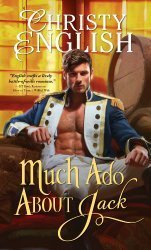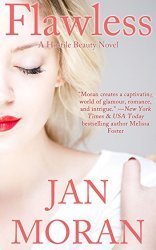Hannah Fielding's Blog, page 97
September 1, 2014
Deepening romance with the male point of view
When a reader picks up a traditional romantic novel, she/he has certain basic expectations:
That the theme of love will permeate the story.
That in the story woman/girl will meet man/boy and fall in love, but encounter obstacles to that love.
That the ending will bring the story to a satisfying (often happy) conclusion.
That the absolute focus of the book will be the heroine and, usually to a far lesser extent, the hero.
The last point is especially interesting, because it’s an expectation that is slowly transforming. The expectation is based on the assumptions that readers of romance fiction are only really interested in the female experience of a love story – presumably because (more assumptions) they’re female themselves, and because the male perspective is less emotional and enthralling and romantic. Thus many romance novels are written entirely in the female protagonist’s point of view – whether told in the first person (‘I married him, reader’) or the third person limited (‘she married him, reader’).
I find it interesting thatthis ‘norm’ of romantic writing that’s become entrenched isn’t present in all the classics, as you may expect. Wuthering Heights, for example, gives more weight to Heathcliff’s story than Cathy’s, to powerful effect. Perhaps it is the development of a strong and vocal female readership group in the last fifty years that has seen the focus shift to women-centric perspectives. Quite how this style of writing evolved is a question wide enough to merit a dissertation, I’m sure!
But one thing is clear: change is afoot.Romantic fiction publisher Chocklit will only publish novels that incorporate the hero’s point of view. Bestselling authors Stephenie Meyer and EL James have toyed with rewriting their smash-hit romance novels from the male perspective. Publishing additional free teaser content, like extra chapters or novellas to accompany publications, in the male point of view is becoming increasingly common. But most prevalent of all is authors working in a male perspective in their largely female-point-of-view love story.
It’s a trend I wholeheartedly embrace. Stepping into the hero’s shoes, just for a little while, allows me as author to show the reader so much more of his life – how he lives apart from the heroine. For example, in The Echoes of Love I write this in a hero-only scene:
Paolo sat on the veranda of his bedroom at the Schiaparelli Hotel, a glass of Rémy Martin VSOP resting on the small enamelled table next to him. He stubbed out the sixth cigarette he’d had since he had come back in after his visit to La Scala. He took a gulp of the potent cognac before lighting his seventh.
The male perspective also allows the author to explore his experience in a way that the reader can trust. The reader can understand the hero better, and often more deeply than the heroine can because the reader is afforded more access to the hero’s inner world. So, for example, a man who seems impermeable and macho can be revealed as tormented and lonely.
He would dream of her tonight, as he had dreamt of her every night since they had met. Those dreams were always tormented, painful – almost nightmares – from which he invariably woke up panting and in a sweat, with at best only a vague recollection of the details. But one thing remained clear: Venetia was always at the heart of them. Was she a danger to him somehow, is that what his subconscious was trying to tell him?
I also like using the male perspective to show the heroine in a new light: as seen by the man who loves, or is falling in love with, her.
Venetia’s tall, slender, long-limbed silhouette swam in front of him, a mass of golden-brown hair falling in lush ringlets down her shoulders, as it had been when he had first set his eyes on her in the street that first night. He could see her face so clearly: delicately sculpted, with high cheekbones, a mouth that was made to be kissed, and curved eyes a shade lighter than her hair, which betrayed a fiery temperament despite having something disciplined about them.
Paolo was used to women swooning around him, and though he was aware that he did not leave Venetia completely indifferent, she was unlike any other woman he had met. She did not seem to have great experience of men. Though obviously efficient at her job, there was nonetheless something … unworldly … almost pure about her; and yet, paradoxically, he was almost certain she had been hurt by a man. Until he had sat opposite her in that noisy, crowded cafeteria on that gloomy wintry night, the only emotion women had been able to awaken in him was animal lust. But Venetia was different: the gold-flecked eyes fringed with thick lashes that met his scrutiny from time to time strangely mirrored a sadness he recognised all too well.
Could I write a book with no male point of view? I don’t think so. To love a romance story, one must love the hero – and to love the hero, one must know the hero.
Could I write a book weighted toward the male point of view, or even entirely in that perspective? No, I don’t think so. For me, the reader’s identification with the heroine is of paramount importance, and I worry that would be compromised by a lack of heroine focus. Balance is key – but I weight the scales in the heroine’s favour.
What do you think? Do you enjoy reading the male point of view in romantic fiction? Do you read hero-centric novels? How does your experience of romance differ based on the author’s approach to point of view? I would love to hear your thoughts.
August 29, 2014
Much Ado About Jack by Christy English
From the blurb:
How to Become London’s Most Notorious Widow:
1. Vow to NEVER remarry
2. Own a ship and become fabulously wealthy
3. Wear the latest risqué fashions in your signature color
4. Do NOT have a liaison at the Prince Regent’s palace with a naval captain whose broad shoulders and green eyes make you forget Rule #1
Angelique Beauchamp, the widowed Countess of Devonshire, has been twice burned by love, and she is certain that no man will ever touch her heart again. But that doesn’t mean she can’t indulge a little—and it would be hard to find a more perfect dalliance than one with the dashing Captain James Montgomery.
After a brief torrid affair, James tries to forget Angelique and his undeniable thirst for more. The luscious lady was quite clear that their liaison was temporary. But for the first time, the lure of the sea isn’t powerful enough to keep him away…
Be still my pounding heart! What a fabulously sassy, sexy read…
Picking up a Christy English book is like going for lunch with a long-time friend: I know I’ll thoroughly enjoy it. I so enjoyed Christy’s Love on a Midsummer Night in her Shakespeare in Love series, so I was keen to read this novel, focusing on Angelique and James. And what a pleasure it was!
I love the connection to Much Ado About Nothing: nothing, at the time of Shakespeare, was pronounced ‘noting’ and meant gossip, and it’s gossip that lies at the heart of this novel – the source of the conflict. In fact, I found the book to be a real eye-opener in terms of making me consider just what it was like to be in the ton; how crass and judgmental its members could be. Stifling!
The writing style is great, full of pace and wit. I love the humour that shines through, such as in:
‘He swallowed hard, and it was as if he could hear his mother’s voice shrill in his ear. He could not skewer an earl at a dinner dance. It would be unseemly.’
The setting is convincing, and I love the era and the customs and costumes it entails. The passion sits beautifully in this world; and such passion! This is a book to make you blush indeed, and yearn, perhaps, for a Scottish sea captain… Goodness me is James (Jack) swoon-worthy! I love how the author alternates points of view in the book, allowing us to really get inside James and understand him.
For me, the standout element of the book is Angelique. I don’t think I’ve ever encountered such a strong heroine (and I’ve read a lot of romantic fiction), and as I turned the pages I was in awe of her. She’s the very epitome of feisty and headstrong, and I love that she doesn’t need James in the sense of being rescued by him as a damsel in distress. I was rather floored by the climax of the story (I won’t give a spoiler), but once I got over the shock I was left with a wide smile and an urge to vote Angelique ‘Romantic Heroine You Least Want to Cross’.
Fantastic, exciting, gripping historical fiction. Heartily recommended!
Much Ado About Jack is available now from Amazon; click on the book cover below to visit the store.
August 27, 2014
How we read ebooks: A new digital-versus-print development
 Recently the Guardian reported on a study on retention of digital reads versus paper reads. Researchers gave participants an Elizabeth George short story. Twenty-five readers read the story in a paperback novel format. Twenty-five read it on a Kindle. Afterwards, the academics tested the readers’retention of objects, characters and settings.
Recently the Guardian reported on a study on retention of digital reads versus paper reads. Researchers gave participants an Elizabeth George short story. Twenty-five readers read the story in a paperback novel format. Twenty-five read it on a Kindle. Afterwards, the academics tested the readers’retention of objects, characters and settings.
Researcher Anne Mangen of Stavanger University, Norway, told the Guardian:
‘The Kindle readers performed significantly worse on the plot reconstruction measure, ie, when they were asked to place 14 events in the correct order.’
The reason suggested? The difference in the way we read on an ereader – its‘haptic and tactile feedback’. Anne Mangen suggests:
‘… the fixity of a text on paper, and this very gradual unfolding of paper as you progress through a story, is some kind of sensory offload, supporting the visual sense of progress when you’re reading. Perhaps this somehow aids the reader, providing more fixity and solidity to the reader’s sense of unfolding and progress of the text, and hence the story.’
The research is part of a European-wide effort tolook into how digitisation affects the reading of text, which so far has indicated that reader on screen may ‘negatively impact cognitive and emotional aspects of reading’.
Fascinating, don’t you think? I read on paper and on my ereader, and my books are published in both formats. Personally, I prefer paper for a closer, more thoughtful read, and digital for lighter reading. I think there is, as the research suggests, a sense that digital reading is quicker, easier; but, ultimately, less careful. Do I take in as many details? Can I perfectly reconstruct the order of plot points? Do I engage quite so well with the characters? Is my emotional response as rich? I think not. Do you agree?
For me, the digital medium speaks of the ‘now-now’ attitude of the modern world: read quickly, easily, and then press on to the next book. Perhaps it also speaks of the ‘throw-away’ culture; fifty years ago objects were imbued with sentiment and much value, and were items to treasure, but today, with the proliferation of cheap, mass-produced products, people consume much more and discard with little thought those items they’ve consumed.
I do value the ereader; I do believe it has a place. But studies such as this show that it cannot sound the death knell of the print book; screen can never obliterate paper entirely. Students, for example, have been shown to digest and retain paper-based material much more effectively than e-material.
When I want to really enjoy a book, I read it on paper. When I’m happy to be a little less connected – reading on a plane, for example, or reading a light book – the ereader suits me fine. I wonder how many others feel the same way, are cognizant of the difference in how they read via the two mediums. Some, no doubt, do connect better to ebooks; the assumption is that the more you read digitally, the more your mind becomes accustomed to that format.
The only option, then, it seems to me is the current state of play in publishing. Publish your novel as an ebook, and as a paperback. And for those who really enjoy the experience of the physical book, add that extra medium, as my publisher has for The Echoes of Love: a hardback edition. Such a treat to read!
August 25, 2014
For the love of colour
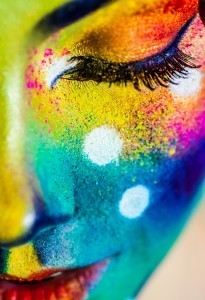 We read in black and white: black text on a white page, be it a paper one or a virtual ‘e-page’ on a screen. But the stories themselves are not black and white, not metaphorically and not – please, never! – descriptively.
We read in black and white: black text on a white page, be it a paper one or a virtual ‘e-page’ on a screen. But the stories themselves are not black and white, not metaphorically and not – please, never! – descriptively.
Any student of literature knows that description is one of the basic tenants of writing. How can a reader imagine the story world without knowing how it looks, sounds, smells? Adjectives are among the first words of a child – big, small, good, bad – and of course colours: red, blue, green. So when we start to write, we instinctively start to use basic colour terms to literally colour the writing.
Imagine a book without colour! I don’t believe such a book – pure black and white, not a hint of colour – has ever been written, for what point would there be in it? Families were so keen to acquire the newly developed colour televisions in the 1960s and 1970s; none preferred black and white! We are drawn to colour – it is moving, warming, inspiring, life itself. We are all colorists at heart, keen to bring colour to the bland and the shadowy.
I love colour. When I think of my childhood, in Alexandria, Egypt, I think of the green borders in my garden, the azure of the Mediterranean, the dark pink render of the walls, the yellow of the lemons the fruit and vegetable man would bring to the door.When I am summering in France, I am drawn to the riot of colours in the garden; when wintering in Kent, the shades of the flames dancing in the open fire catch my eye.
I have written before on this blog of the relationship between the arts, and especially of the close affinity between the artist and the writer. The artist must be so attentive to colour, but I believe that the writer must be also. That is why I endeavor to infuse all of my description with colour, so that my readers are transported from a stuffy commuter train or a grey, drizzly afternoon at home to bright, exotic, memorable locations.
In The Echoes of Love, I wanted to take readers to the Italy I hold in my mind; to paint a literal picture of Venice, Tuscany and Sicily. Sometimes that means adding just a touch of colour:
burnt-sugar creatures, covered with ice-green lichens… a sunglow-yellow strapless lace mini-dress… the rosy shadows from the lighting, which had just turned crimson… a slash of cobalt-coloured ocean through tall hedges… the view of the indigo sea that stretched to infinity beyond the window… the Tuscan Islands of the Tyrrhenian Sea started to shine and blaze with hot ochre light… Clouds of pearly smoke billowed out from under the trees on the Piazza, turning from ruby to rose, from yellow to opalescent green…
Sometimes, I pull together myriad coloursto light a beautiful and romantic setting:
She looked up to her left, gazing at the crimson sun that was declining drowsily on the horizon, its burning light making golden patches on the sea, smooth as a lake at this sunset hour. To her right, the distant countryside lying beyond the trees seemed bluer with those powdery white branches of apple blossom, and as the shadows lengthened, it deepened to a celestial Italian blue. The old brick of the outbuildings was enpurpled, shining with an intense, yet soft, glow. The luminous light was magnificent; the fiery orange, bright pink and patches of serene blue giving way to the swift advance of dusk.
Often in my writing, I think in terms of pictures – my scene as a photograph, a film or a painting. And I consider the ultimate artist of nature, the ‘divine artist’:
She stood leaning against the stone balustrade, her back to the countryside, looking towards the sea. There was no horizon, nothing yet but the soft dusk everywhere so that she couldn’t tell for a while where the sky began. Then, oddly, the sea became darker before the first streaks of colour lit the sky. Venetia wondered what created the unearthly greens and blues and mauves in the sky before the first bars of gold heralded the sun.
Gradually, moment by moment, as Venetia watched entranced, the pale translucent green grew more lovely till at last it seemed as though all tender colours – shiny rose, wisteria, pale blue, the transparent purity of emerald – played on the shimmering fields of the sea, and touched the liquid curves which stretched away and away. Those softly changing colours altered dreamily, as if a divine artist were entertaining kindred spirits with a magnificent show before allowing the sun to bathe the world in molten gold. The array reached up to the horizon and overflowed, spreading over the sea, blotting out the entire colour with sheer light. Colour and light and space … never could one drink enough of such beauty, Venetia thought, as she bathed in that golden glow with her hair rippling gently across her shoulders in the early morning breeze.
What do you think? Does colour call to you, move you? Do you appreciate colourful description in a book? I would love to hear your thoughts.
In celebration of colour, this week I’m tweeting colour quotes with the hashtag #ForTheLoveOfColour. Do retweet if you like and/or jump aboard, and make black and white altogether more vibrant, more spectacular, more alive…
August 23, 2014
An introduction to the Roman gods
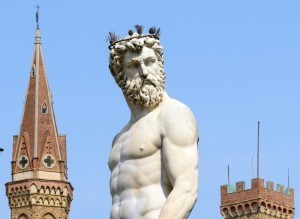 My latest book, The Echoes of Love, is set in Italy: Venice, Tuscany and Sicily. I love Italy for its passion, its beauty, its long and fascinating history, its rich and inspiring cultural heritage… and that which symbolises all: Roman mythology.
My latest book, The Echoes of Love, is set in Italy: Venice, Tuscany and Sicily. I love Italy for its passion, its beauty, its long and fascinating history, its rich and inspiring cultural heritage… and that which symbolises all: Roman mythology.
The Echoes of Love is a modern novel, set at the turn of the millennium, and it is pure romance, not fantasy. But no love story set in Italy is complete without paying homage to the gods, and so in the book I give a sense of those omnipresent and omniscient beings. Who better, for example, to stand as a comparator for my handsome romantic hero, Paolo?
Dressed in a navy-blue silk robe, Paolo was leaning against the trunk of a tree smoking, bathed in auroral light, looking positively unearthly, like a powerful Roman god in an ancient, timeless myth.
But I also like to give a hint of the majestic power of those looking over the mortals in this once god-fearing land:
Paolo’s eyes, that had been serious, impenetrable, and perhaps a little questioning in their depths, changed now, reflecting utter peace. Leaning forward, he bent and kissed her gently, on her forehead first, then on her parted lips. As they stood there close to each other, ringed by moonlight in La Sirena’s garden above the sea, he could see her face, always newly mesmerising to him, become more captivating still – so tranquil was it. Then a cloud engulfed the moon, and dark breezes whipped up. It was as though they themselves were not permitted to look on their full delight in case it angered the gods, and so Paolo picked up Venetia and went into the cottage.
Do you know the Roman gods? Here’s a brief look at the main Roman deities and their domains:
Gods:
Bacchus – wine, festivals, madness, merriment
Cupid (son of Venus) – love
Faunus – nature and fertility
Janus – gates and doors
Jupiter (king of the gods) – lightning and the sky
Mars – war
Mercury (messenger) –thieves, commerce and travellers
Neptune – the sea
Pluto – the Underworld
Saturn – agricultureandharvest
Vulcan – fire, volcanoes and blacksmiths
Goddesses:
Bellona (wife of Mars) – war
Ceres – farming and the earth
Diana –the moon
Fortuna –luck
Juno (wife of Jupiter) – marriage
Minerva – wisdom, handicrafts
Proserpina (wife of Pluto) – springtime
Venus (wife of Vulcan) –love and beauty
Vesta – home
Victoria – victory
For the purposes of a love story, the most important deities are Venus, her son Cupid and the all-powerful Jupiter. But what about Eros, you may be thinking, god of love, lust and sex? He is indeed, but in Greek, not Roman, mythology. It’s so easy to confuse the Roman gods with the Greek ones! Here’s a rundown of important Roman gods with their Greek counterparts.
Bacchus – Dionysus
Bellona – Enyo
Ceres – Demeter
Diana – Artemis
Faunus – Pan
Fortuna – Tyche
Juno – Hera
Jupiter – Zeus
Mars – Ares
Mercury –Hermes
Minerva –Athena
Neptune – Poseidon
Pluto – Hades
Proserpina –Persephone
Saturn – Cronus
Venus –Aphrodite
Vesta –Hestia
Victoria – Nike
Vulcan – Hephaestus
I have these Greek gods in mind at the moment, as I work on a forthcoming novel…
I will leave you today with Paolo and Venetia of The Echoes of Love, both mere mortals wounded by life and love. Once the echoes of their love reach the gods, will the deities decide they deserve their happy ever after?
August 20, 2014
A brief history of the book bloggers
 I love book bloggers! I love book bloggers because of their passion, their hard work, their integrity, their sensibility and their support for authors; and I love book bloggers because I am part of that community as a book reviewer myself. But how did that community come about? Today, I’m touring the timeline of the book bloggers, from non-existent to a highly respected and powerful force in world publishing.
I love book bloggers! I love book bloggers because of their passion, their hard work, their integrity, their sensibility and their support for authors; and I love book bloggers because I am part of that community as a book reviewer myself. But how did that community come about? Today, I’m touring the timeline of the book bloggers, from non-existent to a highly respected and powerful force in world publishing.
1990s: As a reader, you had probably never heard the word blog (web log) unless you were an IT techie. Then, your only source for book reviews was the media, who solely published reviews written by professional book reviewers. The result:
A small, clique of professional book reviewers wielded a lot of power in the publishing world: they decided what was good writing and what wasn’t (and their tastes were fairly literary); and they decided what we, the readers, ought to be reading (unsurprisingly, fairly literary books).
Both publishers and authors had to impress this small group of readers, or new releases would get precious little coverage and poor sales.
2000–2005: Right at the turn of the millennium, developers launched blogging platforms, like Blogger, aimed at regular people, and within five years blogs were gaining interest and credibility, and the role of the book blogger was created. Initially, readers used blogs focused on books simply as a means to journal their reading experiences and to recommend books those friends following their blogs may enjoy. But then the first authors connected to the first book bloggers; the first review requests were made and accepted; the first targeted reviews were created. A quiet revolution had begun, and it gained momentum until…
2005–to date: A community formed! It went something like this.
More readers discovered book blogs.
More readers began book blogs.
More book bloggers discovered each other, and connected.
More authors and publishers discovered book blogs.
More book bloggers received an increasing number of manuscripts for reviews.
More book reviews were published, more widely!
Book blogs became more sophisticated.
Platforms geared to supporting book bloggers, such as Goodreads, were developed and flooded with members.
At the same time, self-publishing had come onto the scene, and by 2008, for the first time in history, more books were independently published than traditionally. In 2009, more than three quarters of all books released were self-published, and publishing houses began to decrease the number of books they published. Independent bloggers and independent authors found a natural affinity, and some of the first self-publishing sensations to hit the headlines owed their success in large measure to the support of the book bloggers; Amanda Hocking, for example, who was averaging 9,000 sales of her self-publishing books per day in 2011 on Amazon, was very open about the bloggers who had supported her. Book bloggers were suddenly famous: a known entity. And it was abundantly clear that as a group they wielded a great deal of power.
The result:
A wide community of book reviewers exists, covering every genre.
All sorts of writing are finding an audience; readers, rather than professional reviewers, are choosing what they want to read.
Both publishers and authors are building relationships with a wide (and ever growing) group of readers.
It’s a friendly community, I find, in the main. Not snobby or needlessly critical, but open and loyal. We’re intelligent and thoughtful readers, and we’re well-read. And the best of us are respectful and supportive of authors. Because above all else, we love books, love books, and what a wonderful development in technology that has brought us to a place where we can make a difference in the world of publishing.
Vive the book bloggers!
August 18, 2014
Book review: Flawless by Jan Moran
Astute, intelligent, gripping romance for the modern woman.
From the first page I was entirely hooked. I love, love the world in which the story is situated. The author so expertly transports you to Beverly Hills and, for a period, Paris, and offers a glimpse of glamour while showing those who work hard behind the scenes to create that glamour. Award ceremonies, luxury hotels, the very best restaurants… but ultimately one of the most magical scenes of the book takes place in a catering kitchen.
This is a romance, but it’s so much more as well. It’s refreshing to find in the genre a book that’s immersed in the world of business; that talks confidently of assets and loans and acquisitions. For me, the business context is utterly fascinating. The author does not bamboozle the reader with complex corporate matters that they couldn’t understand, but neither does she dumb down the story: she writes for an engaged, thinking reader.
The result is a really compelling plot that had me turning the pages faster and faster. The story starts at a high point, with Verena accepting an award for the success of her family business, but as the economic downturn takes hold her life quickly spirals downwards. The further I got, the more I felt there was no way out for the trap into which Verena fell; I felt so sorry for her. Without wishing to spoil the story, I will simply say that the ending, for me, is perfect, and left me with a wide smile.
The characters reach out of the pages and pull you into their lives, and they stay with you long after you close the book. There’s quite a cast (I’m most excited at the thought of more books in the series covering the minor characters in this novel) but that never detracts from the centrality of the main Flawless characters.
I adored the character of Mia, Verena’s grandmother, whose spirit is indomitable – every woman should have a chic, loving, compassionate grandmother such as her! I found the details of her building Valent Swiss Skincare quite fascinating; what a remarkable woman.
The two men who tug on Verena’s heartstrings are Derrick and Lance. I couldn’t stand Derrick from the outset – just the kind of man who leaves me cold – which only increased my pull toward Lance. He’s attractive, he’s generous, he’s thoughtful, he’s the knight in shining armour when required and (swoon!) he’s an amazing chef. Jan’s descriptions of the meals he prepares for Verena had me craving fine dining! But what I love most of all about Lance is his emotional maturity. He knows more than Verena throughout most of the story, but he understands enough of the world to see that it has to be that way – that she must make discoveries for herself.
Then there is the heroine, Verena. What an admirable woman! I very much respected her for her work ethic, for her strong family loyalty and for her no-nonsense practicality. She has such responsibility on her shoulders – for the family business and for the family itself, with twin sisters and a fragile grandmother to support – but she does not bow under the weight; she pushes ever onwards. And she does so with brilliant style. I love this line: ‘When she reached their office door, she took aim with her high heel and kicked it open.’ Twice in the novel I wanted to shout at her, ‘No! You’ve got it wrong!’ – the first when she is far too forgiving and the second when she’s about to… well, I’ll say no more than ‘do something she really shouldn’t’! I love that Jan’s writing took me to the edge in this way; that she creates a heroine whom you can’t fail to care for and understand, but who, like us all, is not flawless.
A fabulous first book in this series – I can’t wait to read the next one.
Flawless is available now from Amazon; click on the book cover below to visit the store.
August 15, 2014
The Ferragosto
 Were I to write now a scene for the characters of my latest novel, The Echoes of Love, set in Italy, it would include them relaxing and enjoying today’s public holiday, the Ferragosto. Celebrated each 15th August, the Ferragosto is a favourite holiday in Italy – so much so that many extend it beyond the day itself, and tourists in Italy often find businesses closed for much of the month!
Were I to write now a scene for the characters of my latest novel, The Echoes of Love, set in Italy, it would include them relaxing and enjoying today’s public holiday, the Ferragosto. Celebrated each 15th August, the Ferragosto is a favourite holiday in Italy – so much so that many extend it beyond the day itself, and tourists in Italy often find businesses closed for much of the month!
Before the Ferragosto,Romans celebrated several festivals in the month of August, to mark the harvest and the end of an arduous period of toiling on the earth. Come 18 BC, the Roman emperor Augustus formalised the festivals into one, the Ferragosto, which was called Feriae Augusti (Augustus’s rest) and ran through all of August. During the rest period, people enjoyed horse races, as in the Paliodell’Assunta in Siena (see my recent post ‘The Joust of the Bear’ for more on the palio). Work animals were allowed to rest – and sometimes decorated with flowers; and masters tipped their workers (this later became compulsory). For a brief time, all came together as equals and enjoyed the summer.
When Augustus began the holiday in relation to the harvest, much was made of honouring ancient gods:
Conso,god of the fields
Diana, goddess of wood, cycles of the moon and motherhood
Opi,goddess of fertility
Vertumno,god of the seasons and the harvest
But then the Catholic Church took the holiday as its own (it’s unclear when, but it was established by the Middle Ages), and it’s now celebrated as the Holy Day of Obligation in memorial of the Assumption of the Virgin Mary.
Fast-forward to the 20th century and the Ferragosto became associated with travel, when in the 1920s the state put on ‘People’s Trains of Ferragosto’ to offer means by which to go on holiday. The discounted fares meant those who’d been unable to afford holidays could go on a gitafuori porta (day trip outside the city gates).
Initially, many of the inland Italians went to the hills to walk and picnic with a view. In 1832, for example, the press reported a huge crowd on hills outside Rimini – somewhat defeating the object of getting away from the crowds of the city! But the water called: ancient rites calling on Neptune to purify. Coastal towns began to see investment, and the Adriatic Riviera coast became a major draw. For those of Rome who couldn’t make it to the sea, the Piazza Navona was flooded for public bathing.
Today, the tradition of travelling is still very much honoured, and many Italians get away for at least the day, if not several. Beyond enjoying nature, from cities to towns to villages, there are plenty of festivities to enjoy: bonfires and fireworks, torchlit processions, cavalcades, horse races, flag throwing, dances, concerts…
And such feasts! For me, my overriding memory of the Ferragosto when I visited Italy was the taste of fresh watermelon. It’s available in abundance, from roadsides stands, grocers, even bobbing in fountains to stay cool! It’s the ultimate fruit to cool and refresh in the hot weather. It’s not, though, a food that easily affords a delicate and polite eating etiquette; as the Romans say: ‘Cocomero: Magni, bevi e telavi ‘a faccia’; ‘Watermelon: with it you eat, drink and wash your face all in one go’!
And so, in the scene I would write for Paolo and Venetia of The Echoes of Love, there would be a mountain with a stunning view, and an orb of fire dancing in a dazzlingly blue sky, and a picnic blanket and a hamper, and a feast including hunks of fresh pink watermelon – but napkins; plenty of those!
Buon Ferragosto!
August 12, 2014
The return of serialised literature
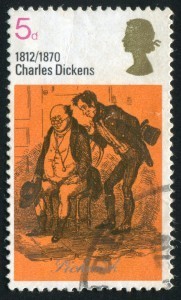 We’re all familiar with serial dramas on the television, but books?
We’re all familiar with serial dramas on the television, but books?
Once, reading a story one instalment at a time was wildly popular. Back in Victorian England, for example, books themselves were premium items – expensive and requiring risky investment from publishers. Thus it was easier to break down a story to test its audience, and print it on the cheap paper of newspapers and magazines.
Charles Dickens is one the best known writers of serialised fiction. His book The Pickwick Papers was so popular it created a market for that kind of work. Other writers whose works were serialised include Alexandre Dumas, Eugene Sue,Wilkie Collins, Gustave Flaubert, Leo Tolstoy, Fyodor Dostoevsky, Sir Arthur Conan Doyle,Henry James, Harriet Beecher Stowe and Herman Melville.
Writing for serialisation meant:
Writing long books!The Count of Monte Cristo, for example, spanned 139 instalments. Writers were paid by the episode, so they had good reason to write plenty of them.
Structuring stories so that each chapter stood alone with a start, middle and end – and often a cliffhanger to make the reader desperate to read the next instalment. (In New York, when the ship bearing the end of Dickens’ The Old Curiosity Shop arrived in port, it was mobbed by readers desperate to know whether Little Nell would make it!)
Keeping the writing tight. The episodes weren’t necessarily concise, but there was no room for digression or waffling, or you’d lose the reader’s short attention span.
Clearly, these areas of focus for the writers of the time were all beneficial to the works they created. That’s one of the reasons that serialised fiction is enjoying something of a renaissance. The digital revolution has created the means for writers to play with all kinds of serialisation ideas:
Releasing a book as a series of short ebooks.
Posting a novel chapter by chapter on Facebook.
Publishing as you write on Wattpad.
Tweeting 140 characters at a time on Twitter.
The last – and quite possibly the most avant-garde – has hit the headlines recently with David Mitchell, the award-winning author of Cloud Atlas, sharing a story via what he calls the ‘diabolical treble-strapped textual straitjacket’ of Twitter. It’s a fairly popular pursuit these days (there’s even a Twitter Fiction Festival).
If you’re thinking about serialisation, I think the main decision to make is whether to publish as you go, or write your entire work and then break it down. Clearly, many writers in the 19th-century had to write as they went – they may have been several episodes ahead of that which was most recently published, but they had no time to craft an entire work, edit it rigorously and then break it down. I wonder how that affected their writing quality? Certainly they would have needed to plan their work meticulously before beginning.
Personally, were I to consider seralising my fiction, I know I would have to write the entire work, polish it until it gleamed, and then send out the first part. But I admire those with the courage to just go for it, and I do think readers on platforms like Wattpad are understanding and respectful of those who are writing as they go – and therefore sometimes wish they could go back and change something.
What do you think of serialised fiction? Should it make a major comeback? Do you enjoy reading a work in parts – eagerly anticipating the next instalment; having the time to digest what you’ve read before moving on to the next part of the story? Do you read Twitter tales and books published in parts on the Kindle? I would love to hear your thoughts!
August 10, 2014
The language of romance
 I grew up speaking French, predominantly – it was the language used at my school, for example. But because I lived in Egypt, it was essential I could speak Arabic. My parents insisted on my being fluent in English. And my half-French, half-Italian governess was careful to perfect my French while also weaving in a good knowledge of Italian. The result: I’ve always been aware of language.Perhaps, as a young girl, there were moments when I grumbled about learning so much – after all, reading (in French) or riding on my bike or playing with my friends was much more fun! But I grew into a deep passion for languages, and a fascination for them: the look of words on the page, the feel of them on the tongue, the sound of them on the ear. That interest in languages very much comes through in the books I write, none more so than The Echoes of Love.
I grew up speaking French, predominantly – it was the language used at my school, for example. But because I lived in Egypt, it was essential I could speak Arabic. My parents insisted on my being fluent in English. And my half-French, half-Italian governess was careful to perfect my French while also weaving in a good knowledge of Italian. The result: I’ve always been aware of language.Perhaps, as a young girl, there were moments when I grumbled about learning so much – after all, reading (in French) or riding on my bike or playing with my friends was much more fun! But I grew into a deep passion for languages, and a fascination for them: the look of words on the page, the feel of them on the tongue, the sound of them on the ear. That interest in languages very much comes through in the books I write, none more so than The Echoes of Love.
When Ifirst visitedItaly, I was so swept away by the passion and romance of the setting that I knew one day I would set a love story there. And when I came to write The Echoes of Love, I found that as well as including aspects of the culture and the physical setting, using the language was essential for me in establishing what it means to be a young woman falling in love in Venice and Tuscany and Sardinia. Take the following extract:
When four o’clock came, Venetia headed back to San Marco’s square and met Francesca at their usual haunt, Fritelli. The café was teaming with Venetians, the way Venetia liked it because the rest of the year this beau monde retreated into their homes, taking refuge from the tourist stampede. Being surrounded by these elegant people, listening to their musical language, was essential to her because without it she felt she was missing out on a crucial element of life in Venice. To be in Venice without its citizens was to know the city’s stones but not its soul.
The language matters to my heroine, Venetia – it’s real, it’s what lies beneath the mask of Venice, what it may show to a tourist; and it matters to me as the writer.
Just a simple word – vaporetto, carnevale, trattoria– can convey so much of the place and the atmosphere than I could ever describe in English. Italian is so beautiful; how can one write a beautiful love story set there without paying homage to its language?
Of course, I write in English, and I can’t expect my English-speaking readers to know Italian, so I looked to find ways to weave in the language of Italy. A word here and there, in description, sets the scene, and often so much more eloquently than the English term: caffeteria and palazzo, for example, are so much prettier than café and squares, and il Conteis to my ear more dramatic and romantic than ‘the Count’.
But where the Italian comes through most is in the dialogue, where I incorporate just enough to remind the reader that they’re in Italy. Both Venetia and Paolo, speak Italian. At their first meeting Paolo comments on Venetia’s fluency, saying ‘You’re not Italian? You speak Italian like a native?’ and Venetia explains that her Venetian godmother insisted she learn the language. Thus, with both characters able to converse in both English and Italian, I was able to use both languages for their conversations. For example:
‘Vatutto bene, are you alright?’
‘Andiamo? Shall we go?’
‘Non tipreoccupare, don’t worry.’
‘Ancoraunavoltaseivenuto in miosoccorso, once more you’ve come to my rescue.’
‘Dio ha cositanto da perdonarci, God in his great kindness every day forgives each one of us.’
‘Non c’èpeggiorcieco di chi non vedrà, there is none so blind as he who will not see.’
Then, of course, there are the terms of endearment, like cara and amore mio and carina and tesoromio that flow from Paolo’s lips when he is with Venetia. I love the sound of such words; they are so onomatopoeic.
Italian is one of the Romance languages (along with Spanish, Portuguese, French and Romanian). In this sense, Romance simply defines them as a group of languages derived from Vulgar Latin, that used by the lower classes of the Roman Empire (as opposed to Classical Latin, spoken and written by the upper classes). But I would argue that these languages are also supremely romantic in the modern sense. I loved incorporating Italian in The Echoes of Love, and I’m very much enjoying weaving in another evocative language, Spanish, to my latest work – details to follow soon!



